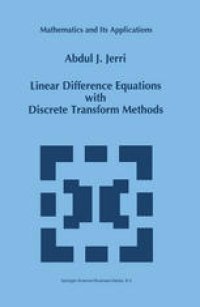
Ebook: Linear Difference Equations with Discrete Transform Methods
Author: Abdul J. Jerri (auth.)
- Tags: Difference and Functional Equations, Computational Mathematics and Numerical Analysis, Integral Transforms Operational Calculus, Mathematical Modeling and Industrial Mathematics
- Series: Mathematics and Its Applications 363
- Year: 1996
- Publisher: Springer US
- Edition: 1
- Language: English
- pdf
This book covers the basic elements of difference equations and the tools of difference and sum calculus necessary for studying and solv ing, primarily, ordinary linear difference equations. Examples from various fields are presented clearly in the first chapter, then discussed along with their detailed solutions in Chapters 2-7. The book is in tended mainly as a text for the beginning undergraduate course in difference equations, where the "operational sum calculus" of the di rect use of the discrete Fourier transforms for solving boundary value problems associated with difference equations represents an added new feature compared to other existing books on the subject at this introductory level. This means that in addition to the familiar meth ods of solving difference equations that are covered in Chapter 3, this book emphasizes the use of discrete transforms. It is an attempt to introduce the methods and mechanics of discrete transforms for solv ing ordinary difference equations. The treatment closely parallels what many students have already learned about using the opera tional (integral) calculus of Laplace and Fourier transforms to solve differential equations. As in the continuous case, discrete operational methods may not solve problems that are intractable by other meth ods, but they can facilitate the solution of a large class of discrete initial and boundary value problems. Such operational methods, or what we shall term "operational sum calculus," may be extended eas ily to solve partial difference equations associated with initial and/or boundary value problems.
This book covers the basic elements of difference equations and the tools of difference and sum calculus necessary for studying and solving, primarily, ordinary linear difference equations. It is lucidly written and carefully motivated with examples from various fields of applications. These examples are presented in the first chapter and then discussed with their detailed solutions in Chapters 2-7. A particular feature is the use of the discrete Fourier transforms for solving difference equations associated with, generally nonhomogeneous, boundary conditions. Emphasis is placed on illustrating this new method by means of applications. The primary goal of the book is to serve as a primer for a first course in linear difference equations but, with the addition of more theory and applications, the book is suitable for more advanced courses.
Audience: In addition to students from mathematics and applied fields the book will be of value to academic and industrial researchers who are interested in applications.
This book covers the basic elements of difference equations and the tools of difference and sum calculus necessary for studying and solving, primarily, ordinary linear difference equations. It is lucidly written and carefully motivated with examples from various fields of applications. These examples are presented in the first chapter and then discussed with their detailed solutions in Chapters 2-7. A particular feature is the use of the discrete Fourier transforms for solving difference equations associated with, generally nonhomogeneous, boundary conditions. Emphasis is placed on illustrating this new method by means of applications. The primary goal of the book is to serve as a primer for a first course in linear difference equations but, with the addition of more theory and applications, the book is suitable for more advanced courses.
Audience: In addition to students from mathematics and applied fields the book will be of value to academic and industrial researchers who are interested in applications.
Content:
Front Matter....Pages i-xxi
Sequences and Difference Operators....Pages 1-40
Sum Calculus and the Discrete Transforms Methods....Pages 41-137
Basic Methods of Solving Linear Difference Equations....Pages 139-280
Discrete Fourier Transforms....Pages 281-328
The Discrete Sine (DST) and Cosine (DCT) Transforms for Boundary Value Problems....Pages 329-353
The z-Transform for Initial Value Problems....Pages 355-383
Modeling with Difference Equations....Pages 385-404
Back Matter....Pages 405-442
This book covers the basic elements of difference equations and the tools of difference and sum calculus necessary for studying and solving, primarily, ordinary linear difference equations. It is lucidly written and carefully motivated with examples from various fields of applications. These examples are presented in the first chapter and then discussed with their detailed solutions in Chapters 2-7. A particular feature is the use of the discrete Fourier transforms for solving difference equations associated with, generally nonhomogeneous, boundary conditions. Emphasis is placed on illustrating this new method by means of applications. The primary goal of the book is to serve as a primer for a first course in linear difference equations but, with the addition of more theory and applications, the book is suitable for more advanced courses.
Audience: In addition to students from mathematics and applied fields the book will be of value to academic and industrial researchers who are interested in applications.
Content:
Front Matter....Pages i-xxi
Sequences and Difference Operators....Pages 1-40
Sum Calculus and the Discrete Transforms Methods....Pages 41-137
Basic Methods of Solving Linear Difference Equations....Pages 139-280
Discrete Fourier Transforms....Pages 281-328
The Discrete Sine (DST) and Cosine (DCT) Transforms for Boundary Value Problems....Pages 329-353
The z-Transform for Initial Value Problems....Pages 355-383
Modeling with Difference Equations....Pages 385-404
Back Matter....Pages 405-442
....